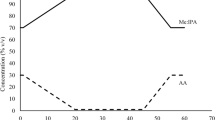Summary
Pharmacokinetic studies of animal and human skin are often advantageously performed with low levels of C-14. We detail an efficient wet ashing method capable of detecting 20 dpm per sample, equivalent to twice the background level, thus permitting complete kinetic assays with 1 μCi or less of C-14 per subject.
Zusammenfassung
Pharmakokinetische Untersuchungen mit tierischer und menschlicher Haut werden oft vorzugsweise mit niedrigen Spiegeln von C14 durchgeführt. Wir stellen eine effiziente Feucht-Veraschungsmethode vor, die erlaubt, 20 dpm pro Ansatz zu erfassen, was dem doppelten Basiswert entspricht. So können vollständige Untersuchungen mit 1 μCi oder weniger von C14 pro Versuchsobjekt durchgeführt werden.
Similar content being viewed by others
References
Anjo DM, Feldmann RJ, Maibach HI (1980) Methods for predicting percutaneous penetration in man. In: Mauvais-Jarvis P, Vickers CFH, Wepierre J (eds) Percutaneous absorption of steroids. Academic Press, London, pp 31–51
Feldmann RJ, Maibach HI (1965) Penetration of C-14 hydrocortisone through normal skin. Arch Dermat 91:661–666
Maibach HI, Feldmann RJ (1967) The effect of DMSO on percutaneous penetration of hydrocortisone and testosterone in man. Ann NY Acad Sci 141:423–427
Author information
Authors and Affiliations
Rights and permissions
About this article
Cite this article
Bucks, D., Maibach, H. Measurement of low level carbon-14 in biologic specimens by wet ashing. Arch Dermatol Res 271, 241–244 (1981). https://doi.org/10.1007/BF00409452
Received:
Issue Date:
DOI: https://doi.org/10.1007/BF00409452




